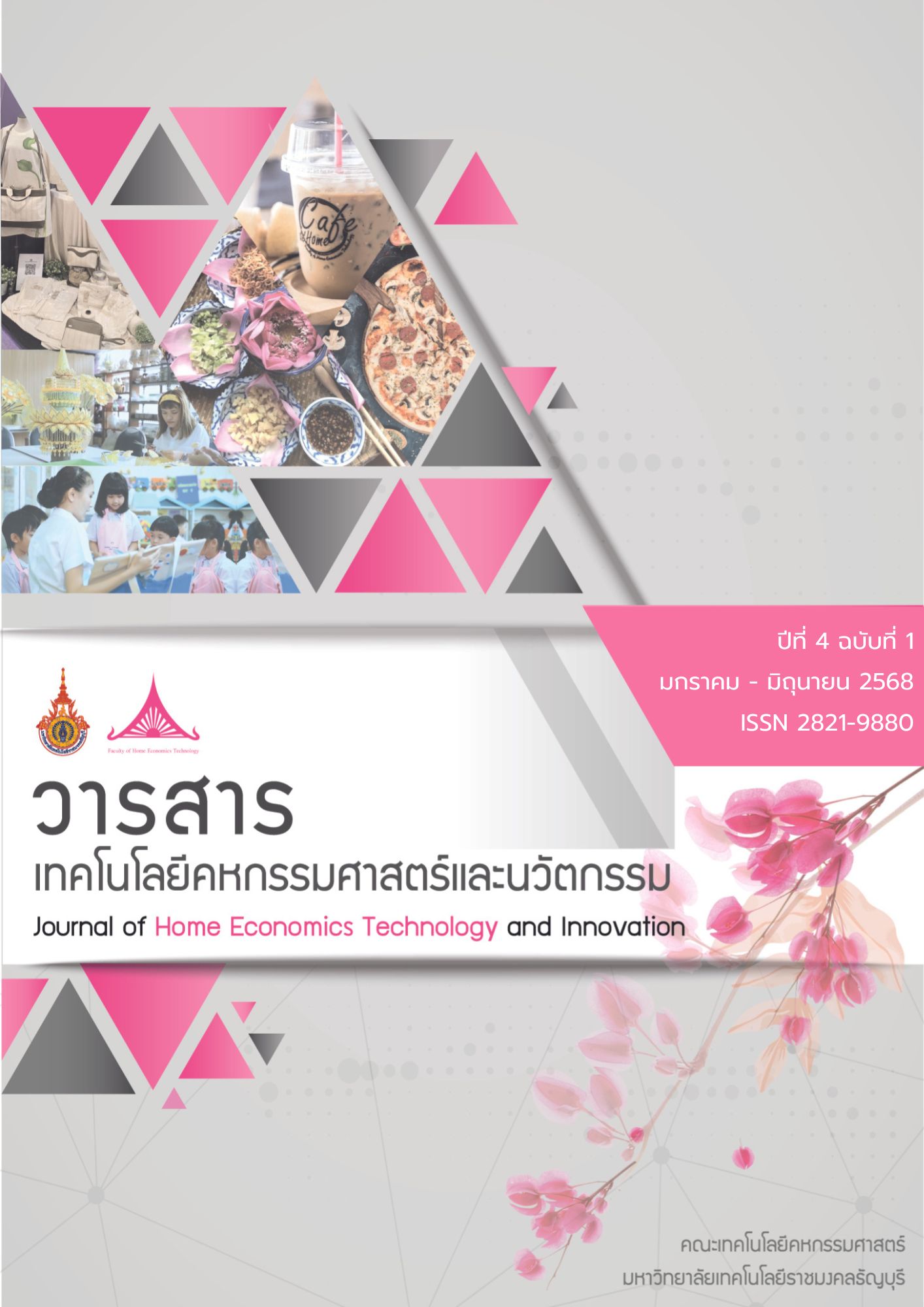Sensory Evaluation and Consumer Acceptance of Herbal Cookies
Main Article Content
Abstract
The research aimed to investigate the quantity of herbal ingredients used as substitutes for wheat flour in cookie production and consumer acceptance. The study focuses on ginger and lemongrass at three level : 2 %, 3.5 %, and 5%. For finger root, it is also at three levels but slightly different from the ginger and lemongrass : 1%, 2%, and 3%. Sensory quality was assessed using a 9-point hedonic scale with a panel of 10 food experts, while consumer acceptance was evaluated through surveys involving 120 participants. Data analysis employed frequency, percentage, mean, and standard deviation.
The result indicated that cookies containing 3.5% ginger received the highest overall liking scores, closely resembling the control formula (scores ranging from 7.60 to 8.00), outperforming cookies with both 2% and 5% ginger. Similarly, cookies with 3.5% lemongrass achieved higher liking scores than those with lower or higher concentrations (scores between 5.60 and 7.70). In contrast, cookies with finger root showed a preference for the formulation containing 1% finger root over those with higher concentrations (scores ranging from 3.80 to 6.20). The tester for consumer acceptance, cookies made with 3.5 % ginger received high rating across all evaluated attributes (scores between 4.23 to 4.58). Therefore, substituting wheat flour with 3.5% ginger powder not only enhances the nutritional value of cookies but also provides beneficial antioxidants and phenolic compounds, making these cookies a suitable healthy snack option for consumers.
Article Details
Articles published are copyright of the Journal of Home Economics Technology and Innovation. Rajamangala University of Technology Thanyaburi The statements contained in each article in this academic journal are the personal opinions of each author and are not related to Rajamangala University of Technology Thanyaburi and other faculty members at the university in any way Responsibility for all elements of each article belongs to each author. If there is any mistake Each author is solely responsible for his or her own articles.
References
กนกกาญจน์ เอี่ยมสะอาด. (2564, 3 พฤศจิกายน). กระชาย ยอดยาสมุนไพร หยุดโรคระบาดจากไวรัส& เสริมภูมิคุ้มกันชีวิต. สืบค้นเมื่อ 15 ธันวาคม 2567 จาก https://dmh.go.th/news/view.asp?id=2420
กรมการแพทย์แผนไทยและการแพทย์ทางเลือก. (2565, 20 พฤษภาคม ). เปิดตำรับ 10 สมุนไพรไทย อีกหนึ่งทางเลือกบรรเทาอาการโควิด-19. สืบค้นเมื่อ 15 ธันวามคม 2567 จาก https://www.hfocus.org/content/2022/05/25130
กรมควบคุมโรค กระทรวงสาธารณสุข. (ม.ป.ป.). โรคติดเชื้อไวรัสโคโรนา 2019. สืบค้นเมื่อ 25 สิงหาคม 2564 จาก https://ddc.moph.go.th/viralpneumonia/.
กองวิชาการและแผนงาน กรมการแพทย์แผนไทยและการแพทย์ทางเลือก กระทรวงสาธารณสุข. (2564, 16 เมษายน). แนวทางปฏิบัติทางการแพทย์แผนไทยและการแพทย์ทางเลือก เพื่อป้องกันการแพร่ระบาดของโรคติดเชื้อไวรัสโคโรนาสายพันธุ์ใหม่ 2019 (COVID-19) ฉบับปรับปรุงครั้งที่ 1. สืบค้นเมื่อ 25 สิงหาคม 2564 จากhttps://ttm.skto.moph.go.th/document_file/pr002.pdf
กรุงเทพธุรกิจ. (2567, 24 มิถุนายน ). คนยุคใหม่ ใส่ใจสุขภาพ “อาหารสุขภาพ” โตรับเทรนด์. สืบค้นเมื่อ 10 ธันวาคม 2567 จาก https://www.bangkokbiznews.com/health/well-being/1131405
ชัยรัตน์ พึ่งเพียร. (2552). สมบัติและกิจกรรมการต้านอนุมูลอิสระของสารสกัดหยาบจากขิงที่สกัดด้วยคาร์บอนไดออกไซด์เหนือวิกฤตและการประยุกต์ใช้สารสกัดในไอศกรีม. (วิทยานิพนธ์ วิทยาศาสตรมหาบัณฑิต สาขาวิชาเทคโนโลยีอาหาร คณะวิทยาศาสตร์และเทคโนโลยี). มหาวิทยาลัยสงขลานครินทร์.
ซาฟียะห์ สะอะ. (2562). กระชาย : ราชาแห่งสมุนไพรที่ขึ้นชื่อว่า โสมไทย. วารสารอาหาร, 49 (4), 16-21.
ธานินทร์ ศิลป์จารุ. (2557). การวิจัยและวิเคราะห์ข้อมูลทางสถิติด้วย SPSS และAMOS. (พิมพ์ครั้งที่ 15). กรุงเทพฯ : ห้างหุ้นส่วนสามัญบิสซิเนสอาร์แอนด์ดี.
รักชนก ภูวพัฒน์ และคณะ. (2560). การเปรียบเทียบสารออกฤทธิ์ทางชีวภาพจากลำต้นและใบตะไคร้หอมในพื้นที่จังหวัดนราธิวาส. วารสารมหาวิทยาลัยนราธิวาสราชนครินทร์, 9 (1), 136-137.
โรงแรมอวานี่ พลัส หัวหิน รีสอร์ท แอนด์ วิลล่าส์. (2564). คุกกี้มะพร้าว.
สถาบันการแพทย์แผนไทย กรมการแพทย์แผนไทยและการแพทย์ทางเลือก. (ม.ป.ป.). เพิ่มภูมิต้านทานด้วยสมุนไพรไทยในสถานการณ์โควิด-19 . สืบค้นเมื่อ 15 ธันวาคม 2567 จาก https://ittm.dtam.moph.go.th/images/knowleaga/21
ศิวพงษ์ ตันสุวรรณวงค์, วนิษา ปันฟ้า, ดวงนภา แดนบุญจันทร์, สุวศิน พลนรัตน์ และนวรัตน์ วิริยะเขษม. (2567). การตรวจสอบคุณภาพทางจุลินทรีย์และเอกลักษณ์ทางเคมีของเครื่องดื่มนมกระชาย. วารสารสุขภาพและสิ่งแวดล้อมศึกษา, 9 (1), 319-327.
ศูนย์นวัตกรรมการแพทย์แผนไทย. (2565, 7 กันยายน ). 8 สมุนไพรไทย รอบบ้าน ช่วยเสริมภูมิคุ้มกันต่อต้านไวรัส. สืบค้นเมื่อ 10 ธันวาคม 2567 จาก https://ttmic.co.th › 8-สมุนไพรไทย-รอบบ้าน-ช่วย
ศูนย์นวัตกรรมการแพทย์แผนไทย. (2565, 7 กันยายน). อาหารสมุนไพร. สืบค้นเมื่อ 10 ธันวาคม 2567 จาก https://ttmic.co.th
หน่วยแพทย์ทางเลือก คณะแพทยศาสตร์โรงพยาบาลรามาธิบดี มหาวิทยาลัยมหิดล. (ม.ป.ป.). มารู้จัก "ขิง" กันเถอะ. สืบค้นเมื่อ 10 ธันวาคม 2567 จาก https://www.rama.mahidol.ac.th/altern_med/th/km/22dec2023-1037
อภิเดช พงษ์ประจักษ์, นวพัชร ใจเพชร, เรืองฤทธิ์ ทองทา และพรพาชื่น ชูเชิด. (2565). ผลของการทดแทนไขมันบางส่วนด้วยเนื้ออะโวคาโดต่อคุณสมบัติทางกายภาพและทางประสาทสัมผัสของคุกกี้เนย. วารสารเทคโนโลยีคหกรรมศาสตร์และนวัตกรรม, 1 (2), 77-86.
Marak, N. R., Malemnganbi, C. C., Marak, C. R. and Mishra, L. K. (2019). Functional and antioxidant properties of cookies incorporated with foxtail millet and ginger powder. J Food Sci Technol, 56 (11), 5087–5096. doi: 10.1007/s13197-019-03981-6.
Money Buffalo. (2567, 4 มิถุนายน). เปิดเทรนด์ อาหารเพื่อสุขภาพ โกยเงิน 32 ล้านล้านบาททั่วโลก. สืบค้นเมื่อ 10 ธันวาคม 2567 จาก https://www.moneybuffalo.in.th/business/healthy-food-trends
Lee, Chae-Sun., Lim, Hyeon-Sook .and Cha, Gyung-Hee. (2015). Quality Characteristics of Cookies with Ginger Powder. Korean Journal of Food and Cookery Science, 31(6), 703-717. DOI: 10.9724/kfcs.2015.31.6.703
Kaushal, M., Vaidya, D., Gupta, A., Kaushik, R. and Verma, A. K. (2019). Bioactive compounds and acceptance of cookies supplemented with ginger flour. Journal of Pharmacognosy and Phytochemistry, 8 (6), 185-188.


